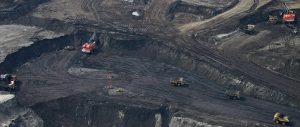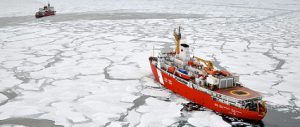Downtown Nuuk on a rainy evening in July has the air of a town wanting to be somewhere else. Cars wait patiently at the town’s two traffic lights while teenagers on BMX bikes ride aimlessly round the shopping precinct. The temperature hovers around 10° Celsius, the leaden skies touched by the faint hue of the midnight sun. It is high summer in the capital of Greenland, 240 kilometres south of the Arctic Circle.
On the streets, Inuit traders display their wares in cardboard boxes, selling anything from cut-price DVDs to fur hats. Large Soviet-style apartment blocks loom up behind — reminders of a misguided attempt in the 1950s and 1960s to urbanise the country’s population. Towards the old harbour and the rocky fringes of the grassy shoreline, wooden, two-storey houses painted blue, red and yellow are dots of colour in the grey.
All this could be about to change. About 750 kilometres north-west of Nuuk, out to sea, a Scottish company is drilling for oil. Greenland, the world’s largest island, with its tiny population of 56,000, is standing on the brink of an oil rush. The potential wealth that lies off its shores is turning the country — an empty wilderness three times the size of Texas — into a battleground. The global oil industry, striving to feed the world’s hunger for energy, is engaged in a struggle against environmental groups who believe that this delicate Arctic landscape should remain untouched.
A spill in such cold waters, they warn, would be calamitous, not least for fishing, currently Greenland’s main source of domestic income. But that fear must compete with the hope, shared by some of the biggest players in the energy industry, that the sea floor around Greenland holds one of the world’s largest remaining undiscovered oil finds.
In 2008, a study of the basins of the Arctic by the US Geological Survey estimated that three provinces off the coast of Greenland combined could yield up to 52 billion barrels of oil equivalent (which includes natural gas) — as much as has been drilled out of the North Sea in the past 40 years. This caught the attention of companies including ExxonMobil and Royal Dutch Shell, and it is why Scotland’s Cairn Energy is now prospecting there.
The numbers also stuck in the mind of Kuupik Kleist, Greenland’s prime minister and leader of the country’s Inuit Ataqatigiit party. Kleist sees oil as a possible way finally to achieve Greenland’s economic independence. Although self-governing since 2009, the country remains a dependency of Denmark.
Each year the island receives an annual subsidy of about 3.2 billion Danish kroner [about US$600 million] from Denmark, which helps fund social services. The export of fish brings in revenues of about two billion kroner (US$375 million). Everything else is imported.
The country’s potential hydrocarbon wealth “holds a very big economic potential”, says Kleist. He is sitting at an elegant glass table in his office in the centre of Nuuk. Dressed in an unprepossessing blue T-shirt and sweater — he is about to go on his holiday (“hunting and fishing”) — Kleist does not give the impression of a man burdened by what critics describe as a Faustian pact with the oil industry. For him, the argument is clear: the government wants to diversify the economy, and oil and gas present an enormous opportunity.
The irony of Greenland becoming a major producer of hydrocarbons, and contributing to the climate change that is helping to melt its own glaciers, is not lost on Kleist. But the root of the problem, he says, is in the failure of the rest of the world to curb its appetite for energy. “The western press is focusing on whether Greenland should or should not exploit its natural resources,” he says. “They don’t focus on the consumption of energy.”
Kleist also rejects opinions from abroad about what he regards as Greenland’s sovereign prerogative to exploit its resources. “We claim our right to economic development,” he says, “and we claim our right to be independent from former colonial powers.”
Although oil has not yet been found in commercial quantities, Greenland’s government has set up a sovereign wealth fund similar to Norway’s. It would hold revenues in trust for the nation. Denmark, Kleist explains, has no claim to any oil revenues. He says he is well aware that rapid wealth can bring risks, especially to a society that has been provided for from the outside for what he describes as “a very long time and for too long a time”.
If his vision is clear, the future does not appear quite as straightforward to the country’s mostly Inuit inhabitants. Inuits make up some 85% of the population of Greenland — the rest are Danes — and while there appears to be broad local support for the oil industry, particularly its revenues, many are wary of moving too quickly.
Blowing bubbles for his baby daughter while waiting for the bus, Uusaqqak Kristensen, a 32-year-old school teacher, says the arrival of the energy industry is “the start of something” for Greenland. Investment in infrastructure is badly needed.
Henrik Leth, general manager of the Employers’Association of Greenland, agrees, but he also wants to see new work opportunities for local inhabitants. There is already a sharp disparity between the incomes of Greenlanders and those who come from overseas to work in the Arctic for a year or two. Leth worries that the lack of relevant skills among Greenlanders means they could become mere “spectators” amid the oil rush.
The country’s leaders, he says, are seeing “only the money part of it” and should force international energy companies to make a lasting investment in the local workforce. The government insists it is doing this. Cairn Energy, for instance, has signed an “impact benefit agreement”, under which it must invest a certain amount in the local economy. Leth remains cautious: “If we don’t do it right, it’s a failure, no matter what happens.”
—
It is a month earlier, late June, and huddled above the engine room of the Esperanza, a Greenpeace vessel floating some 130 kilometres off the coast of Greenland, 18 activists are about to embark on “Operation Foreigner”.
Frank Hewetson, also known as “The Colonel”, raises a hand for silence. “The swell is significant, so I want you to mentally prepare yourselves for the ladders,” he says. “Just don’t slip.”
Seventeen volunteers beam back at him, alight with nerves. They are the other face of Greenland’s energy rush.
Among the professional eco-types (unkempt facial hair, socks, sandals) are an anthropologist, a sous-chef and a professional bass guitarist. “It’s a lifelong activist’s dream to be on a Greenpeace ship like this,” says Iris Cheng, an environmental policy co-coordinator from Hong Kong.
The group — all dressed in orange, body-hugging dry suits — waddle down the Esperanza’s port side on a rope ladder. Negotiating the rise and fall of the frigid ocean below, they drop into dinghies.
Some 15 minutes later, a sleepy voice crackles over the Esperanza’s radio. It is a policeman from Greenland onboard a battleship charged with maintaining a 500-mile [800-kilometre] exclusion zone around the Leiv Eiriksson, one of the exploration rigs hired by Cairn Energy for the summer drilling season. He says the activists — who by this point are climbing the rig’s steel legs — are breaking the law. He orders the captain to call them back. Madeleine Habib, the Esperanza’s silver-haired captain, politely dismisses the request. “What do you expect us to do?” she says. “Sit around and sing ‘Kumbaya’?”
Officially, the Greenpeace activists are storming the rig to search for Cairn’s “spill response plan” — a mandatory document that sets out what action an oil company will take in the event of a spill — and which Greenpeace says was initially not being made public by the Greenlandic government.
The protest, or “non-violent direct action” in Greenpeace jargon, is the largest the organisation has staged at sea and part of what it has called “the defining environmental battle of our age”. For international climate-change campaigners, drilling for oil and gas in the Arctic is the final insult. “We are drawing a line in the ice,” says Nick Young, a volunteer and blogger from New Zealand. “If we see the melting of the ice caps as an opportunity to drill for oil, then what hope is there?”
A showdown in Greenland is also a welcome fillip for an organisation, which, for the past 15 years, has struggled with fluctuating membership and accusations that on its journey from the fringe to the mainstream it has lost some of its pioneering spirit. The Arctic’s melting seascape provides the perfect backdrop for a revival: for many, Greenpeace is still associated with its campaigns to protect whales and seals in the 1970s and 1980s.
“It’s a return to our roots,” says Ben Ayliffe, a senior campaigner for Greenpeace. “And you have it in an area which tugs on people’s heartstrings. They understand its beauty and the threat companies like Cairn pose. It’s classic David and Goliath.”
Not that, financially speaking, Greenpeace is a puny opponent. The group has an annual budget of 206 million euros [US$290 million], out of which it has been able to rent a helicopter for the use of the news media to cover its activities in Greenland, and pay the 16,000 euros [US$22,400] a day necessary to keep the Esperanza and its sister ship, Arctic Sunrise, out at sea.
The activists’ ambition is to take the fight to all corners of the high Arctic. “We’re not just bearded blokes in inflatable boats,” says John Sauven, Greenpeace’s executive director in London. He likens the group’s direct action in Greenland to throwing a stone into a pond. “There’s a ripple effect. It makes conversations happen and the risk-factor [for oil companies] climbs dramatically.”
NEXT: Conflicting demands on Nuuk government
Sylvia Pfeifer is the Financial Times’ energy editor. Christopher Thompson is a UK companies reporter for the FT.
For a video about Greenland’s oil rush go to www.ft.com/greenlandoil.
© Copyright The Financial Times Limited 2011
Homepage image © Steve Morgan/Greenpeace shows activists at the Leiv Eiriksson oil rig off the coast of Greenland




